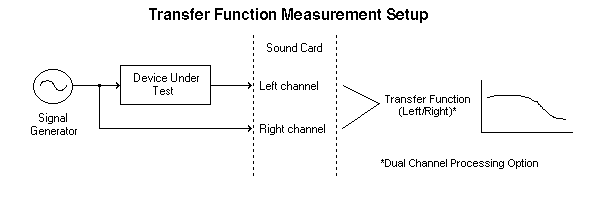Contents
- Index
- Previous
- Next
Transfer Functions
A transfer function is a total measurement of the amplitude and phase response of an audio device.
A key part of an accurate transfer function is the removal of the input test signal response from the final measurement. This is done by passing a sample of the input signal to the second channel of the analyzer and removing its response from the response of the device under test.

You should use logarithmic amplitude scaling; subtracting two logarithmic quantities equates to division of their ratio values.
Key Settings:
Mode: Real-Time
Views: Spectrum, Phase
Sampling Rate: At least twice the highest frequency produced by the device under test
FFT size: 4096 typical
Averaging: 4
Peak Hold: Off
Smoothing Window: Hanning
Dual Channel Spectral Processing: Real Transfer Function Left/Right"
Sampling Format: 16 bit Stereo
Frequency scaling: your choice
Amplitude scaling: Logarithmic
Spectral Weighting: flat
Procedure:
Connect a noise generator to the input of the device under test.
Connect the output of the device under test to the Left input channel of the analyzer.
Connect same signal generator to the Right input channel of the analyzer.
Run the analyzer until the average spectrum response settles to a consistent level.
Interpretation:
The spectrum display contains the amplitude response of the device and the phase display contains the phase response.
